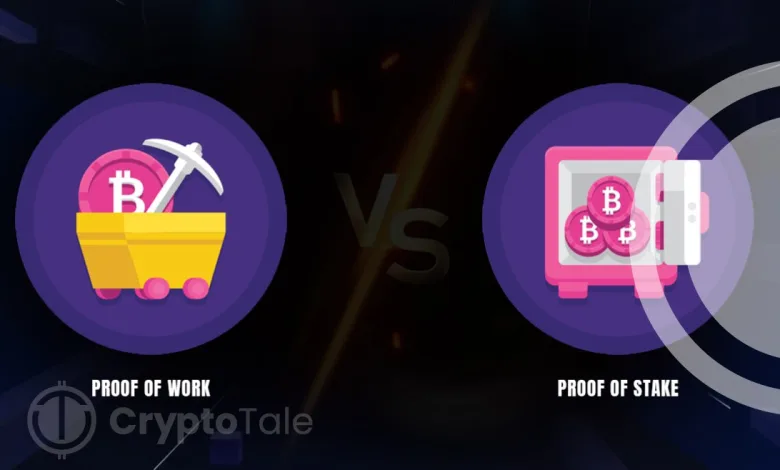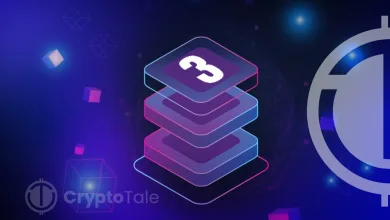Major Differences Between Proof of Stake And Proof of Work

Crypto is known for its decentralization, as transactions happen without a central authority. But without a mechanism to verify transactions, there would only be chaos; therefore, a consensus mechanism came into existence. Two major consensus mechanisms exist: Proof of Stake (PoS) and Proof of Work (PoW). These mechanisms are used to verify transactions that happen in the blockchain, guaranteeing security and integrity. Here, you can learn about the two mechanisms and the difference between PoW and PoS.
What is Proof-of-Stake (PoS)?
Proof of Stake (PoS) is a consensus mechanism used to validate transactions and include entries on a block. It was created as an alternative to Proof of Work, requiring lower computational resources and energy to verify blocks and transactions. Additionally, attacks on PoS networks are less likely due to their compensation structures.
Unlike PoW, where miners compete for the right to verify transactions and earn rewards, PoS only requires validators to stake their coins on the network to earn rewards. Validators with the highest amount of staked coins will be prioritized when validating a block and earning network fees as a reward. Each blockchain has its own set of standards, requiring a minimum amount of coins to be staked before becoming a validator.
How Does Proof-of-Stake Work?
The initial block, or the first block, is coded directly into the program, and each subsequent block refers to the prior block to get the updated ledger. In the PoS mechanism, there are no miners who mine the blocks; instead, there are only validators. The creation of blocks in PoS is referred to as minting or forging.
In PoS, validators take on the role of verifying transactions and appending blocks to the blockchain. To become a validator, one must stake a portion of a blockchain’s native coins for a period of time through a smart contract. The validator who gets tasked with generating a new block will be chosen based on the amount of staked coins. The larger the stake, the higher the chances of being chosen.
The validator chosen for the task must verify the transactions and update the block. Once the block is added to the blockchain, the validator will receive a reward in the form of transaction fees.
What are the pros and cons of PoS?
Pros:
When compared with the proof of work, the amount of energy required for minting is much less. In addition, the PoW system’s transaction speed is faster, and the degree of impact on the environment is much less. They are also more scalable due to the higher transactions per speed (TPS). This allows PoS systems to process large amounts of requests per second with less latency.
PoS eliminates the need for energy-intensive hardware to mine blocks, allowing users with little capital to get into the game of minting blocks. They are also less vulnerable to risks associated with 51% attack.
Cons:
In the PoS system, there is nothing to stop validators (Nothing at Stake) from supporting multiple blocks during a fork, as there is no penalty, and they don’t need to expand as much energy as in PoW. It can lead to the concentration of wealth in the hands of entities that stake large amounts of coins as they have a higher chance of being chosen as validators. Although PoS are resistant to hacks, they may not be as tamper-resistant or secure as PoW.
What is Proof-of-Work (PoW)?
Proof of Work (PoW) is another consensus mechanism that can be used to validate transactions by solving complex computational puzzles. While the concept of PoW was developed in the 1990s, it was only after the launch of Bitcoin it became popular and was used to create blocks on the Blockchain network.
PoW requires substantial computing power from a network of devices to solve the complex mathematical puzzle. In a chain of events, it became extremely hard for miners to add a new block to the chain due to the power-hungry algorithms. The process of solving the puzzle is called mining. The miner who completes the complex puzzle first will be able to generate a new block and will get rewards in Bitcoins.
Standard personal computers lack the processing power or chips capable enough to mine Bitcoins. So, miners use Application Specific Integrated Circuit (ASIC) mining machines with specialized chips for faster and more efficient Bitcoin mining.
How Does Proof-of-Work Operate?
A blockchain is a distributed ledger composed of a sequence of blocks arranged in an orderly fashion. The ledger keeps track of all transactions in the blockchain and encrypts it with the blockchain hashing function. The function can be used to verify whether the data contained in the block has been tampered.
The hash of the first block, often called block zero, is used by the second block, and each subsequent block relies on the previous block’s hash function for an updated ledger. This makes any alteration to a block ineffective because all the information from each block is incorporated into the subsequent block.
Miners are engaged in a race where they expand their computing resources to provide the hash that fits the requirements of the network. The miner who gets the correct hash first will get to amend the block and receive the reward.
What are the pros and cons of PoW?
Pros:
Proof of Work (PoW) safeguards the Bitcoin ledger from tampering, as any attempt to alter a blockchain would require tampering with most blocks, which is impractical due to the associated costs and time. Essentially, an entity or organization would need to acquire more than half (51%) of the network’s computing power to implement any modifications.
Within a Proof of Work (PoW) framework, if a blockchain undergoes a fork, miners are given the option to either continue working on the primary blockchain or switch to the new one. This measure is implemented to prevent miners from dividing their computational resources between the two and to avert additional forks in the blockchain.
Cons:
The demand for substantial computing power in executing complex mathematical calculations for puzzle-solving results in significant electricity consumption. Additionally, mining contributes to the rapid deterioration of equipment, generation of e-waste, increased operational costs, and inefficient utilization of resources. During network overload, the fees also tend to soar.
Proof-of-Stake (PoS) Vs. Proof-of-Work (PoW)
| PoS | PoW |
| The likelihood of validating a block is based on the number of staked coins or the amount of stake a user holds. | The possibility of mining a block is determined by the amount of computing power that a miner can gather. |
| The creators of blocks are called Validators. | The creators of blocks are called miners. |
| Based on the number of staked coins, the algorithm decides the winner. | The miner who first solves the complex puzzle using computation power is the winner. |
| PoS systems are energy and cost-efficient. | PoW systems are expensive and consumes lot of energy. |
| They are less reliable, and staking helps secure assets by locking them in the network in exchange for a reward. | They are reliable, and the network becomes more secure with the increase in hash rate. |
| The validator receives a network fee as a reward for adding a block to the blockchain. | The first miner to mine a block will get the rewards. |
| It only requires a server-grade device to mine coins. | To mine coins require ASICS and GPUs. |
| There is no penalty for forking, leading to a large number of forks. | PoW system uses an incentive mechanism to automatically solve the issue of forking. |
| To tamper with a block, hackers need to hold 51% of all the coins on the network. | To tamper with a block, hackers need 51% of the computing power. |
| Users only need to stake coins as an initial investment. | Users need to buy a lot of hardware as an initial investment. |
| Ethereum is a well-known blockchain network utilizing the Proof of Stake consensus mechanism. | Bitcoin is a well-known blockchain leveraging the Proof of Work consensus mechanism. |
| To become a validator, users need to buy and stake coins. | To become a miner, users need to buy hardware and energy. |
Conclusion:
There is still no clear consensus on which consensus mechanism is superior. Both the Proof of Stake and Proof of Work have a lot of potential to be tapped. When it comes to the PoS mechanism, most people worry about centralization as the way the mechanism operates is conducive to entities owning large amounts of coins to gain significant control of the system. In the case of the PoW mechanism, if an entity can control more than 50% of the computing power, they have the power to change any records. However, with all its pros and cons, these consensus mechanisms ensure the smooth functionality of blockchain and its decentralized nature.





